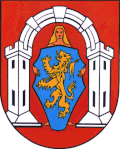This article needs additional citations for verification .(January 2012) |
| Vukovar water tower | |
|---|---|
Vukovarski vodotoranj | |
 Vukovar water tower after the Croatian War of Independence. | |
| General information | |
| Status | Restored |
| Type | Water tower |
| Location | Vukovar, Croatia |
| Coordinates | 45°20′38″N19°00′44″E / 45.3440°N 19.0122°E |
| Construction started | 1962 |
| Completed | 1968 |
| Height | 50.3 m (165 ft) |
| Dimensions | |
| Other dimensions | 2,200 m3 (78,000 cu ft) water capacity |
| Design and construction | |
| Architect | Plan d.o.o. |
| Main contractor | Hidrotehna Zagreb d.o.o. |
| Website | |
| https://vukovarskivodotoranj.hr/ | |
The Vukovar water tower (Croatian : Vukovarski vodotoranj) is a structure in Vukovar, Croatia, and one of the most recognizable symbols of the city and the entire country. Built in 1968, it became a powerful symbol of resistance, sacrifice, and unity during the Croatian War of Independence. During the 1991 siege, Vukovar was heavily attacked by the Yugoslav People's Army and Serbian paramilitary forces. Despite sustaining more than six hundred direct artillery hits, the tower remained standing, testifying to the courage of the defenders and residents of Vukovar and becoming a lasting monument to the struggle for freedom and the independence of the Republic of Croatia. The city itself, though small, played a crucial role in defending the country, standing firm against far superior forces and demonstrating extraordinary resilience in the face of overwhelming odds. [1]



